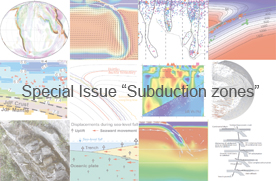Editor(s): S. Buiter, F. Funiciello, and J. van Hunen

26 Nov 2012
Subduction to the lower mantle – a comparison between geodynamic and tomographic models
Solid Earth, 3, 415–432, 2012
09 Oct 2012
Using open sidewalls for modelling self-consistent lithosphere subduction dynamics
Solid Earth, 3, 313–326, 2012
31 Jan 2013
Segmentation of the Izu-Bonin and Mariana slabs based on the analysis of the Benioff seismicity distribution and regional tomography results
Solid Earth, 4, 59–73, 2013
07 Nov 2012
Thermal structure and intermediate-depth seismicity in the Tohoku-Hokkaido subduction zones
Solid Earth, 3, 355–364, 2012
14 Feb 2012
Tomography of the 2011 Iwaki earthquake (M 7.0) and Fukushima nuclear power plant area
Solid Earth, 3, 43–51, 2012
17 Apr 2012
The fate of fluids released from subducting slab in northern Cascadia
Solid Earth, 3, 121–129, 2012
03 Sep 2012
Plate kinematics in the Cantabrian domain of the Pyrenean orogen
Solid Earth, 3, 265–292, 2012
23 Nov 2012
Insight into collision zone dynamics from topography: numerical modelling results and observations
Solid Earth, 3, 387–399, 2012
05 Sep 2012
Numerical models of slab migration in continental collision zones
Solid Earth, 3, 293–306, 2012
13 Feb 2013
Exhumation of (ultra-)high-pressure terranes: concepts and mechanisms
Solid Earth, 4, 75–92, 2013
22 Nov 2012
Three-dimensional thermal structure of subduction zones: effects of obliquity and curvature
Solid Earth, 3, 365–373, 2012
21 Dec 2012
Dynamics of interplate domain in subduction zones: influence of rheological parameters and subducting plate age
Solid Earth, 3, 467–488, 2012
22 Feb 2012
Effect of glacial-interglacial sea-level changes on the displacement and stress field in the forearc and along the plate interface of subduction zones
Solid Earth, 3, 63–70, 2012
